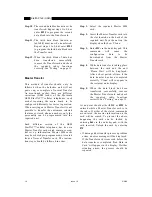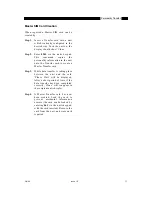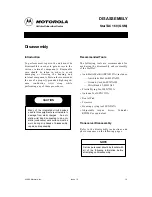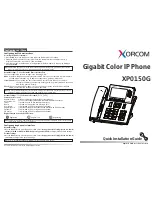
4
Issue 1.0
2/6/98
StarTAC 160 (GSM)
It is designed to carry digital voice and
data over existing copper telephone
cables. The GSM phone will be able to
offer similar features to the ISDN
telephone.
•
Security and Confidentiality
-
Telephone
calls on analogue systems can very easily
be overheard by the use of a suitable radio
receiver. GSM offers vastly improved
confidentiality because of the way in
which data is digitally encrypted and
transmitted.
•
Better Call Quality
-
Co-channel
interference, handover breaks, and fading
will be dealt with more effectively in the
digital system. The call quality is also
enhanced by error correction, which
reconstructs lost information.
•
Efficiency
-
The GSM system will be able to
use spectral resources in a much more
efficient way than previous analogue
systems.
In the figure below, the area bounded by
bold lines represents the total coverage area
of a hypothetical system. This area is
divided into several cells, each containing a
cell site (base station) operating on a given
set of channels which interfaces radiotele-
phone subscribers to the telephone
switching system.
Figure 1: Hypothetical Cell System
The
radiotelephones themselves are capable
of operation on any channel in the system,
allowing them to operate in any cell. Due to
the low power requirements for communi-
cations between radiotelephones in a partic-
ular cell and the cell site, operating channels
may be repeated in cells which are outside
the coverage area of each other.
For example, presume that cell A operates
on channels arbitrarily numbered 1 through
8, cell B operates on channels 9 through 16,
cell C operates on channels 17 through 24
and cell D operates on channels 1 through 8
(repeating the usage of those channels used
by cell A). In this system, subscribers in cell
A and subscribers in cell D could simulta-
neously operate on channels 1 through 8.
The implementation of frequency re-use
increases the call handling capability of the
system, without increasing the number of
available channels. When re-using identical
frequencies in a small area, co-channel inter-
ference can be a problem. The GSM system
can tolerate higher levels of co-channel
interference than analogue systems, by
incorporating digital modulation, forward
error correction and equalization. This
means that cells using identical frequencies
can be physically closer, than similar cells in
analogue systems. Therefore the advantage
of frequency re-use can be further enhanced
in a GSM system, allowing greater traffic
handling in high use areas.
By incorporating Time Division Multiple
Access (TDMA) several calls can share the
same carrier. The carrier is divided into a
continuous stream of TDMA frames, each
frame is split into eight time slots. When a
connection is required the system allocates
the subscriber a dedicated time slot within
each TDMA frame. User data (speech/data)
for transmission is digitized and sectioned
into blocks. The user data blocks are sent as
information bursts in the allocated time slot
of each TDMA frame, see Figure 2: “TDMA
Transmission” on page 5.
•
•
•
•
•
•
•
•
•
•
•
•
CHANNELS
1-8
CHANNELS
CHANNELS
CHANNELS
9-16
1-8
9-16
CELL A
CELL B
CELL D
CELL E
•
CHANNELS
17-24
CELL C
•
CHANNELS
17-24
CELL F
Summary of Contents for cd 160
Page 7: ...viii Issue 1 0 2 6 98 StarTAC 160 GSM ...
Page 9: ...2 Issue 1 0 2 6 98 StarTAC 160 GSM ...
Page 13: ...6 Issue 1 0 2 6 98 StarTAC 160 GSM ...
Page 17: ...10 Issue 1 0 2 6 98 StarTAC 160 GSM ...
Page 25: ...18 Issue 1 0 2 6 98 StarTAC 160 GSM ...
Page 65: ...58 Issue 1 0 2 6 98 StarTAC 160 GSM Figure 27 StarTAC Parts Illustration ...
Page 67: ...60 Issue 1 0 2 6 98 StarTAC 160 GSM ...
Page 75: ...68 2 6 98 ...












































